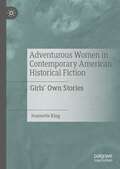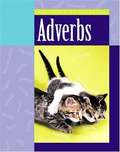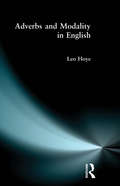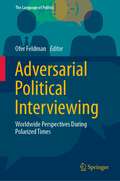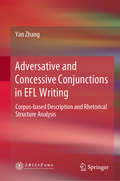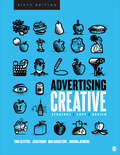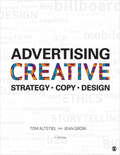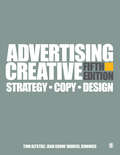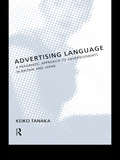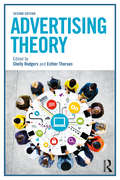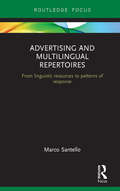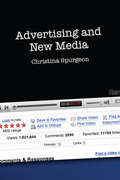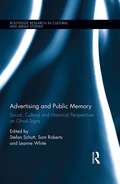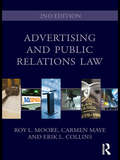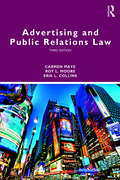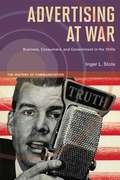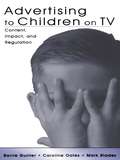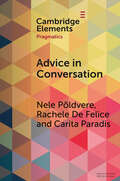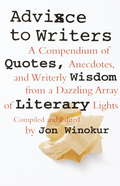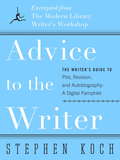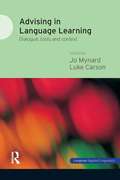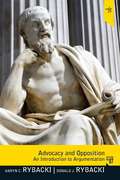- Table View
- List View
Adventurous Women in Contemporary American Historical Fiction: Girls' Own Stories
by Jeannette KingThis book brings together for the first time nine groundbreaking historical novels by women from the United States, Canada and Latin America, united by their focus on female adventurers. These novels introduce the neglected women of history, real and imagined, who accompanied their menfolk to the New World, and enabled its settlement or colonisation. Familiar novelists include Isabel Allende, Audrey Thomas and Jane Smiley, but this book also introduces less familiar writers who have produced richly textured and densely historical novels. In addition to putting women back into history, these writers engage with the literature of the past, including the American canon of male fiction which dominated literary history before the intervention of feminist scholars. The book begins with an introduction to the history of historical fiction and provides a theoretical, historical and geographical context for the novels themselves.
Adverbs (The Magic of Language)
by Ann HeinrichsNo matter if you read quickly or slowly, or whether you start off grumpily or happily, you will surely have a smile on your face once you've learned about adverbs. This book will help young readers identify adverbs and use them in writing and speaking. Adverbs just make reading more fun!
Adverbs and Modality in English (English Language Ser. #No. 21)
by Leo HoyeThis new study on modality in English represents a departure from more traditional approaches to the subject, where the modal auxiliaries have been the usual focus of attention, by examining in detail the nature of their association with different categories of modal adverb. Modality is notoriously complex but the present work offers an accessible introduction to the topic, a comprehensive account of modal-adverb co-occurrence, and a reappraisal of the English modal system. The descriptive framework draws fresh insights from syntactic, semantic and pragmatic approaches to the study of language and communication, and from recent work in corpus linguistics. The book includes contrastive reference to the expression of modality in Spanish and a discussion of modality in such applied contexts as language teaching. A major feature is its reliance on authentic spoken and written language data. The study is suitable for undergraduate and postgraduate students of linguistics, English language, communications studies and related disciplines.
Adversarial Political Interviewing: Worldwide Perspectives During Polarized Times (The Language of Politics)
by Ofer FeldmanThis book presents a collection of studies on political interviews in a variety of broadcast media worldwide. Following the growing scholarly interest in media talk as a dominant form of political communication in contemporary society, a number of eminent international scholars analyze empirical material from the discourse of public figures and interviewer–journalists to address questions related to the characteristics, conduct, and potential effects of political interviews. Chapters span a varied array of cultural contexts: the U.S.A., U.K., Israel, Japan, Italy, Turkey, Greece, Australia, Philippines, Finland, Brazil, Malaysia, Spain, Venezuela, Montenegro, and the European Community, enabling a comparison of the different structures and contents of political interviews in societies from West to East. Authors bring an interest in discourse and conversation analysis, as well as in rhetorical techniques and strategies used by both interviewers and interviewees, from different disciplinary viewpoints including linguistic, political, cultural, sociological, and social–psychological. In doing so, the book develops a framework to assess the extent to which media political interviews and talk shows, and regular news programs, play a central role in transmitting accurate and genuine political information to the general public, and how audiences can make sense of these programs’ output.
Adversative and Concessive Conjunctions in EFL Writing: Corpus-based Description and Rhetorical Structure Analysis
by Yan ZhangThis book explores the usage patterns of a group of adversative and concessive conjunctions in English texts written by Chinese EFL learners and their native speaker counterparts. Focusing on probability profiles and systemic potentials, the study encompasses three stages and combines the strengths of two research methods – the corpus-based approach and text-based analysis – to examine the conjunctions under the theoretical framework of systemic functional linguistics and rhetorical structure theory. Starting with an overview of seventeen conjunctions across two corpora in terms of overall frequency, positional distribution and distribution of semantic categories, the book then offers a more detailed discussion of three individual conjunctions, highlighting the interconnections between 1) syntactic positions and co-occurrence patterns and 2) semantic relations encoded by these conjunctions. Lastly, it presents a case study of one full-length text taken from the learner corpus, applying rhetorical structure theory to provide new insights into the relevance of adversative and concessive relations to text structure. This comprehensive, in-depth analysis is both diagnostic and pedagogically informative.
Advertising Creative: Strategy, Copy, and Design
by Tom Altstiel Jean M. Grow Joanna L. Jenkins Dan AugustineAdvertising Creative, Sixth Edition gets right to the point of advertising by stressing key principles and practical information students and working professionals can use. Drawing on personal experience as award-winning experts in creative advertising, this new edition offers real-world insights on cutting-edge topics, including global, social media, business-to-business, in-house, and small agency advertising. In the new edition, authors Tom Altstiel, Jean Grow, Dan Augustine, and Joanna Jenkins take a deeper dive into the exploration of digital technology and its implications for the industry, as they expose the pervasive changes experienced across the global advertising landscape. Their most important revelation of all is the identification of the three qualities that will define the future leaders of this industry: Be a risk taker. Understand technology. Live for ideas. The latest edition addresses some of the key issues impacting our industry today, such as diversity in the workplace, international advertising, and design in the digital age.
Advertising Creative: Strategy, Copy, and Design
by Tom Altstiel Jean M. Grow Joanna L. Jenkins Dan AugustineAdvertising Creative, Sixth Edition gets right to the point of advertising by stressing key principles and practical information students and working professionals can use. Drawing on personal experience as award-winning experts in creative advertising, this new edition offers real-world insights on cutting-edge topics, including global, social media, business-to-business, in-house, and small agency advertising. In the new edition, authors Tom Altstiel, Jean Grow, Dan Augustine, and Joanna Jenkins take a deeper dive into the exploration of digital technology and its implications for the industry, as they expose the pervasive changes experienced across the global advertising landscape. Their most important revelation of all is the identification of the three qualities that will define the future leaders of this industry: Be a risk taker. Understand technology. Live for ideas. The latest edition addresses some of the key issues impacting our industry today, such as diversity in the workplace, international advertising, and design in the digital age.
Advertising Creative: Strategy, Copy, and Design
by Tom Altstiel Jean M. GrowAdvertising Creative is the first “postdigital” creative strategy and copywriting textbook in which digital technology is woven throughout every chapter. The book gets right to the point of advertising by stressing key principles and practical information students and working professionals can use to communicate effectively in this postdigital age. Drawing on personal experience as award-winning experts in creative advertising, Tom Altstiel and Jean Grow offer real-world insights on cutting-edge topics, including global, social media, business-to-business, in-house, and small agency advertising. In this Fourth Edition, Altstiel and Grow take a deeper dive into the exploration of digital technology and its implications for the industry, as they expose the pervasive changes experienced across the global advertising landscape. Their most important revelation of all is the identification of the three qualities that will define the future leaders of this industry: Be a risk taker. Understand technology. Live for ideas.
Advertising Creative: Strategy, Copy, and Design
by Tom Altstiel Jean M. GrowAdvertising Creative is the first “postdigital” creative strategy and copywriting textbook in which digital technology is woven throughout every chapter. The book gets right to the point of advertising by stressing key principles and practical information students and working professionals can use to communicate effectively in this postdigital age. Drawing on personal experience as award-winning experts in creative advertising, Tom Altstiel and Jean Grow offer real-world insights on cutting-edge topics, including global, social media, business-to-business, in-house, and small agency advertising. In this Fourth Edition, Altstiel and Grow take a deeper dive into the exploration of digital technology and its implications for the industry, as they expose the pervasive changes experienced across the global advertising landscape. Their most important revelation of all is the identification of the three qualities that will define the future leaders of this industry: Be a risk taker. Understand technology. Live for ideas.
Advertising Creative: Strategy, Copy, and Design
by Tom Altstiel Jean M. Grow Marcel JenningsAdvertising Creative, Fifth Edition continues to weave discussions about digital messaging through every chapter. Yet, the underlying theme is still about one thing that never changes—the need for fresh concepts and big ideas in pursuit of the One Thing. This edition introduces a new co-author, Marcel Jennings, who brings a fresh perspective from his background as a copywriter and creative director, as well as teaching at Virginia Commonwealth University. As always, the authors draw upon their experiences as working advertising professionals and teachers to get right to the point, stressing key principles and practical information that students and working professionals can use to communicate more effectively to build memorable brands. They also address some of the key issues impacting our industry today, such as gender equality, diversity in the workplace, and business ethics.
Advertising Creative: Strategy, Copy, and Design
by Tom Altstiel Jean M. Grow Marcel JenningsAdvertising Creative, Fifth Edition continues to weave discussions about digital messaging through every chapter. Yet, the underlying theme is still about one thing that never changes—the need for fresh concepts and big ideas in pursuit of the One Thing. This edition introduces a new co-author, Marcel Jennings, who brings a fresh perspective from his background as a copywriter and creative director, as well as teaching at Virginia Commonwealth University. As always, the authors draw upon their experiences as working advertising professionals and teachers to get right to the point, stressing key principles and practical information that students and working professionals can use to communicate more effectively to build memorable brands. They also address some of the key issues impacting our industry today, such as gender equality, diversity in the workplace, and business ethics.
Advertising Language: A Pragmatic Approach to Advertisements in Britain and Japan
by Keiko TanakaKeiko Tanaka offers an analysis of the linguistic devices that are used in advertisements, looking at the strategems which advertisers employ to gain and retain the attention of their audience. Using relevance theory as a framework, she sets out its key aspects and applies them to the language of written advertising in Britain and Japan. Particular emphasis is placed on `covert communication', puns and metaphors, and the book contains a unique chapter on images of women in Japanese advertising. It is fully illustrated throughout with recent contrasting advertisements drawn from the two countries. The book provides a compelling analysis of the language of advertising, and an exploration of Relevance Theory that will be of interest to scholars in many fields.
Advertising Theory (Routledge Communication Series)
by Esther Thorson Shelly RodgersAdvertising Theory provides detailed and current explorations of key theories in the advertising discipline. The volume gives a working knowledge of the primary theoretical approaches of advertising, offering a comprehensive synthesis of the vast literature in the area. Editors Shelly Rodgers and Esther Thorson have developed this volume as a forum in which to compare, contrast, and evaluate advertising theories in a comprehensive and structured presentation. With new chapters on forms of advertising, theories, and concepts, and an emphasis on the role of new technology, this new edition is uniquely positioned to provide detailed overviews of advertising theory. Utilizing McGuire’s persuasion matrix as the structural model for each chapter, the text offers a wider lens through which to view the phenomenon of advertising as it operates within various environments. Within each area of advertising theory—and across advertising contexts—both traditional and non-traditional approaches are addressed, including electronic word-of-mouth advertising, user-generated advertising, and social media advertising contexts. This new edition includes a balance of theory and practice that will help provide a working knowledge of the primary theoretical approaches and will help readers synthesize the vast literature on advertising with the in-depth understanding of practical case studies and examples within every chapter. It also looks at mobile advertising in a broader context beyond the classroom and explores new areas such as native advertising, political advertising, mobile advertising, and digital video gaming.
Advertising and Multilingual Repertoires: from Linguistic Resources to Patterns of Response (Routledge Focus on Linguistics)
by Marco SantelloAdvertising and Multilingual Repertoires explores advertising from the perspective of multilingual audiences. Santello introduces the key linguistic processes involved in advertising discourse, and analyses the relationship between the linguistic repertoires of audiences and language use in advertising. This book: Showcases the most recent advancements in linguistic research as applied to the study of advertising and multilingualism, adopting an approach that focuses on linguistic resources; Examines how advertisements make use of language(s), including Italian and the use of English as a foreign language, in order to attract attention and persuade their audience; Familiarises readers with response mechanisms that bilinguals and multilinguals experience when exposed to advertising in different languages; Demonstrates both qualitative and quantitative approaches to researching the intersections between language and marketing. Advertising and Multilingual Repertoires is key reading for postgraduate students and researchers in the field of language and advertising.
Advertising and New Media
by Christina SpurgeonThis comprehensive introduction explores the evolving relationship between new media, advertising and new media consumers. Tracing the shift from 'mass' to 'my' media, Advertising and New Media critically evaluates the social and cultural implications of increased interactivity and consumer creativity for the future of advertising, with examples drawn from the USA, the UK, Europe, Australia and the peoples Republic of China.Features include: evaluation of consumer-generated advertising, including the Coke Mentos phenomenon, and comparative analysis of the Dove ‘Real Beauty’ and Axe/Lynx ‘Effect’ campaigns interviews with industry practitioners, providing first-hand insights on the impact of new media on advertising.
Advertising and Public Memory: Social, Cultural and Historical Perspectives on Ghost Signs (Routledge Research in Cultural and Media Studies)
by Sam Roberts Leanne White Stefan SchuttThis is the first scholarly collection to examine the social and cultural aspects on the worldwide interest in the faded remains of advertising signage (popularly known as ‘ghost signs’). Contributors to this volume examine the complex relationships between the signs and those who commissioned them, painted them, viewed them and view them today. Topics covered include cultural memory, urban change, modernity and belonging, local history and place-making, the crowd-sourced use of online mobile and social media to document and share digital artefacts, ‘retro’ design and the resurgence in interest in the handmade. The book is international and interdisciplinary, combining academic analysis and critical input from practitioners and researchers in areas such as cultural studies, destination marketing, heritage advertising, design, social history and commercial archaeology.
Advertising and Public Relations Law
by Roy L. Moore Carmen Maye Erik L. CollinsAddressing a critical need, Advertising and Public Relations Law explores the issues and ideas that affect the regulation of advertising and public relations speech. Coverage includes the categorization of different kinds of speech afforded varying levels of First Amendment protection; court-created tests for laws and regulations of speech; and non content-based restrictions on speech and expression. Features of this second edition include: overviews and synopses for each chapter extended excerpts from major court decisions appendices providing a chart of the judicial system, a summary of the judicial process, an overview of alternative dispute resolution mechanisms, and the professional codes for media industry and business associations online materials for instructors. The volume is intended for upper-level undergraduate and graduate students in media, advertising and public relations law or regulation courses. It also serves as an essential reference for advertising and public relations practitioners.
Advertising and Public Relations Law (Routledge Communication Series)
by Roy L. Moore Carmen Maye Erik L. CollinsAddressing a critical need, Advertising and Public Relations Law explores the issues and ideas that affect the regulation of advertising and public relations speech, some of the most dynamic and prevalent areas of professional communications today. This updated third edition explores the categorization of different kinds of speech and their varying levels of First Amendment protection as well as common areas of litigation for communicators such as defamation, invasion of privacy, and copyright and trademark infringement. Features of this edition include: A new chapter on Internet-related laws affecting advertising and public relations speech. History and background of major legal theories affecting professional communicators. Extended excerpts from major court decisions. Overviews of relevant federal and state regulatory schemes, including those promulgated and enforced by the FTC, FCC, FDA and others. Appendices providing a legal glossary, a chart of the judicial system, sample model releases and copyright agreement forms. The volume is developed for upper-level undergraduate and graduate students in media, advertising and public relations law or regulation courses. It also serves as an essential reference for advertising and public relations practitioners.
Advertising at War: Business, Consumers, and Government in the 1940s
by Inger L StoleAdvertising at War challenges the notion that advertising disappeared as a political issue in the United States in 1938 with the passage of the Wheeler-Lea Amendment to the Federal Trade Commission Act, the result of more than a decade of campaigning to regulate the advertising industry. Inger L. Stole suggests that the war experience, even more than the legislative battles of the 1930s, defined the role of advertising in U.S. postwar political economy and the nation's cultural firmament. She argues that Washington and Madison Avenue were soon working in tandem with the creation of the Advertising Council in 1942, a joint effort established by the Office of War Information, the Association of National Advertisers, and the American Association of Advertising Agencies. Using archival sources, newspapers accounts, and trade publications, Stole demonstrates that the war elevated and magnified the seeming contradictions of advertising and allowed critics of these practices one final opportunity to corral and regulate the institution of advertising. Exploring how New Dealers and consumer advocates such as the Consumers Union battled the advertising industry, Advertising at War traces the debate over two basic policy questions: whether advertising should continue to be a tax-deductible business expense during the war, and whether the government should require effective standards and labeling for consumer products, which would render most advertising irrelevant. Ultimately the postwar climate of political intolerance and reverence for free enterprise quashed critical investigations into the advertising industry. While advertising could be criticized or lampooned, the institution itself became inviolable.
Advertising to Children on TV: Content, Impact, and Regulation
by Barrie Gunter Caroline Oates Mark BladesConcern is growing about the effectiveness of television advertising regulation in the light of technological developments in the media. The current rapid growth of TV platforms in terrestrial, sattelite, and cable formats will soon move into digital transmission. These all offer opportunities for greater commercialization through advertising on media that have not previously been exploited. In democratic societies, there is a tension between freedom of speech rights and the harm that might be done to children through commercial messages. This book explores all of these issues and looks to the future in considering how effective codes of practice and regulation will develop.
Advice in Conversation: Corpus Pragmatics Meets Mixed Methods (Elements in Pragmatics)
by Carita Paradis Nele Põldvere Rachele De FeliceThis Element is a contribution to a new generation of corpus pragmatics research by taking as its starting point the multifaceted nature of speech acts in conversation, and by adopting a mixed-methods approach. Through a unique combination of theoretical, qualitative, quantitative, and statistical approaches, it provides a detailed investigation of advice-giving and advice uptake in relation to (i) the range of constructions used to give advice in different discourse contexts and at different points in time, and (ii) their interaction with dialogic and social factors of advice uptake as key components of frames of advice exchanges in natural conversation. Using data from the London-Lund Corpora of spoken British English, the Element shows, firstly, that there are systematic differences in advising between discourse contexts over the past half a century, and, secondly, that who gave the advice and how they did it are the strongest predictors of the advisee's response. This title is also available as Open Access on Cambridge Core.
Advice to Writers: A Compendium of Quotes, Anecdotes, and Writerly Wisdom from a Dazzling Array of Literary Lights
by Jon WinokurJon Winokur, author of the bestselling The Portable Curmudgeon, gathers the counsel of more than four hundred celebrated authors in a treasury on the world of writing. Here are literary lions on everything from the passive voice to promotion and publicity: James Baldwin on the practiced illusion of effortless prose, Isaac Asimov on the despotic tendencies of editors, John Cheever on the perils of drink, Ivan Turgenev on matrimony and the Muse. Here, too, are the secrets behind the sleight-of-hand practiced by artists from Aristotle to Rita Mae Brown. Sagacious, inspiring, and entertaining, Advice to Writers is an essential volume for the writer in every reader.
Advice to the Writer
by Stephen KochFrom Stephen Koch, former chair of Columbia University's graduate creative writing program, comes essential and practical advice drawn from The Modern Library Writer's Workshop. With nearly thirty years of teaching experience, Stephen Koch has earned a reputation as an astute and benevolent mentor; and with Advice to the Writer, his lucid observations and commonsense techniques have never been more accessible. Here Koch dispenses sound guidance for those moments when the muse needs a little help finding her way: in "Shaping the Story," he untangles plot; in "Working and Reworking," he explains the most teachable (yet least often taught) of all writerly skills: revision; and in "The Story of the Self," he delves into autobiography. Featuring handpicked commentary from some of our greatest authors, Advice to the Writer is a unique introduction to this maddening and intoxicating pursuit. Praise for Stephen Koch's The Modern Library Writer's Workshop "An extraordinarily comprehensive and practical work by a master craftsman and a master analyst of the craft."--Madison Smartt Bell, author of All Souls' Rising and Anything Goes "Stephen Koch was my teacher long ago. Now he is everyone's teacher, indelibly. This is a book not just for the beginning writer but for every writer."--Martha McPhee, author of the National Book Award nominee Gorgeous Lies "The Modern Library Writer's Workshop is a treasure trove of wisdom, both immensely practical and philosophical, entertaining and thought-provoking. Koch takes us inside the writing process, and it is impossible not to emerge transformed."--Joanna Hershon, author of Swimming
Advising in Language Learning: Dialogue, Tools and Context
by Jo Mynard Luke CarsonAdvising in Language Learning (ALL) brings together examples of advising practice and research from various international contexts in a fast-developing field. A theoretical model based on constructivism and sociocultural theory (the "Dialogue, Tools and Context Model") is proposed and supported thoughout the book, as each of the contributions focuses on one or more areas of the model. In this volume the editors set out the general aims and understandings of the field, illustrating the innovative manner in which advisors around the world are working with learners and researching the practice of ALL.
Advocacy And Opposition: An Introduction To Argumentation, Seventh Edition
by Karyn Charles Rybacki Donald Jay RybackiAdvocacy and Opposition: An Introduction to Argumentation presents a comprehensive and practical approach to argumentation and critical thinking for the beginner who needs to construct and present arguments on questions of fact, value, and policy. Advocacy and Opposition offers a theoretical view of the nature of argument in our society, a discussion of arguing as a form of communication, and a focus on how arguments are created using the Toulmin model of argument. By blending traditional and contemporary views on the nature of argument (including multicultural perspectives on the purpose and process of argument, ethics, and values), Advocacy and Opposition makes students more aware of both the development of theory and practice, providing a well-rounded approach to their study of argumentation.
